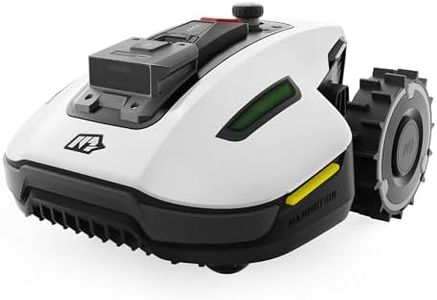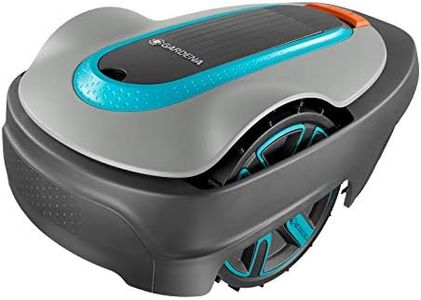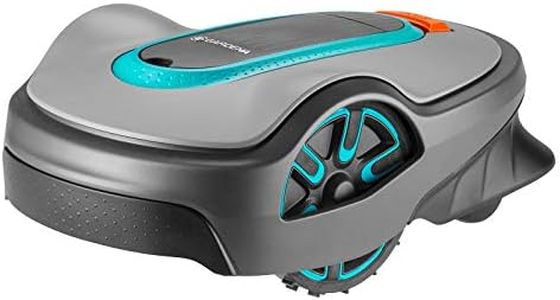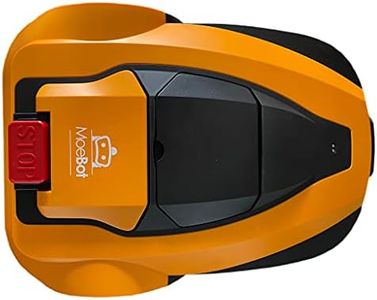We Use CookiesWe use cookies to enhance the security, performance,
functionality and for analytical and promotional activities. By continuing to browse this site you
are agreeing to our privacy policy
5 Best Robotic Lawn Mowers
From leading brands and best sellers available on the web.Buying Guide for the Best Robotic Lawn Mowers
Robotic lawn mowers are automated machines designed to keep your lawn maintained without the need for manual mowing. Choosing the right robotic lawn mower can greatly simplify yard maintenance and free up your time. Before selecting a model, consider the size and layout of your lawn, the kind of grass you have, as well as how much involvement you want in setup and maintenance. Understanding the key features can help you make a choice that matches your yard and lifestyle.Cutting Area CapacityCutting area capacity tells you how much square footage the robotic mower can effectively handle. This is crucial because choosing a mower rated for a smaller area than your lawn will mean uneven work and possible overuse of the device. Models are often divided into small (up to 1/8 acre or 500 square meters), medium (up to 1/2 acre or 2,000 square meters), and large (beyond 1/2 acre) categories. You should measure your lawn and select a mower that matches or slightly exceeds your space so it completes mowing cycles without straining or missing patches.
Battery Life and Charging TimeThe battery life indicates how long the mower can run on a single charge, while charging time is how long it takes to recharge before being able to mow again. Longer battery life means the mower can handle larger areas or tougher grass without frequent interruptions, while shorter charging times help the mower get back to work quicker. For smaller, simpler lawns, a basic battery may be enough, but for larger or more complex yards, opt for a model with longer battery life and shorter charging durations so the mower can handle daily or weekly schedules more efficiently.
Cutting Height AdjustmentCutting height adjustment is the range of grass heights the mower can handle. This is important because different grass types and user preferences require variable mowing heights. Entry-level mowers might offer fewer, fixed settings whereas more advanced ones allow for fine-tuning. If you care about lawn aesthetics, changing seasons, or have multiple grass types, look for a model that offers easy and flexible cutting height settings so you can adapt your mowing as needed.
Navigation and Lawn MappingNavigation refers to how the mower finds its way around your lawn. Some mowers use random patterns and boundary wires, while advanced models have smart mapping and GPS functionality. Basic navigation works well for simple lawns, but for yards with slopes, obstacles, or complex designs, advanced mapping ensures that all areas are covered efficiently and reduces the chance of the mower getting stuck. If your yard has intricate landscaping or lots of obstacles, prioritize a mower with sophisticated navigation and mapping features.
Weather and Rain SensorsWeather and rain sensors help the mower detect wet conditions and either pause or return to dock to prevent mowing during rain. This protects both your lawn and the mower from potential damage and ensures the blades do not clog with wet grass. If you live in an area with unpredictable weather or frequent rain, this feature is valuable, as it allows you to set and forget the mower without worrying about weather-related problems.
Security and Safety FeaturesSecurity and safety features include PIN codes, lift and tilt sensors, and alarms. PIN codes prevent unauthorized use, while lift and tilt sensors stop the blades when the mower is picked up or tipped. This is particularly important for homes with children or pets, or if you are concerned about theft. If safety or security is a priority for you, look for models that offer robust security and safety measures to protect both people and the device itself.
App and Smart ConnectivitySmart connectivity allows you to control and monitor the mower via phone apps or smart home systems. Features might include scheduling, manual controls, status reports, and notifications. For tech-savvy users or those who want extra convenience, models with app connectivity provide more flexible and remote management options. If you value automation and being hands-off, this is an important feature to prioritize.






